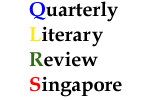 |
 |
|||||||||||||
|
By Chia Yueh Chin
a single headlamp
Madeleine Lee’s début poetry collection comes with impressive heralds. A slim volume, it comes with two forewords, written by no less than Lee Tzu Pheng and Suchen Christine Lim. Lee (Tzu Pheng) tells us that the poems have a “lyrical simplicity that is not without linguistic liveliness”, while Lim pronounces them to be “simple words on a page that startled [her] into seeing”. As such, the reader expects the poems to be simple yet startling.
Do the poems live up to their billing?
Some do and some don’t.
Among those that do, one that bears repeated reading is “at an art gallery with a four year old”. It starts off with a clean, sparse stanza like the white walls it evokes:
where we went
The trained reader picks up the quiet, deft use of alliteration, assonance and word placement that makes this stanza an aural and visual artwork. The collocation of the velvety “w” sounds in the first line aptly suggests the leisurely pace of the parent and child around the gallery, and very few would fault the stark placement of “adorn” in the fourth line, set apart, arresting the reader’s eye like a painting arrests the viewer’s attention, the word performing the action it denotes.
Off to a fine start, the reader is rewarded again with the third stanza, which may startle you into seeing flying arrows anew:
you liked the one
Again, there is the singularly skilful use of alliteration and diction. “Flailing” is so picturesque and exact a word, connoting the desperation, futility and childishness of war and its weapons. The poetic persona slyly undermines the child’s enthusiasm for war scenes with just one word: “flailing”.
And the ending does not disappoint. After a slighting dismissal of the “evil”, “no guts” and “just guns and glory” colonialists depicted in the paintings in three stanzas, the binary distinctions conveniently sharpened by the persona’s need to simplify concepts for the child, we are left with the final, almost enigmatic stanza that leaves us with no comment but a word-painting:
at the end
Like a painting, the final stanza is open to interpretation, even though the reader is aware of the persona’s distaste for war. Artworks that leave no room for imagination and interpretation do not bear repeated viewing. Thankfully, “at an art gallery with a four year old” is one work that does.
Given the talent and skill exhibited in “at an art gallery”, it is quite disappointing that some of the poems are sub-standard. Sub-standard in the sense that they do not startle the reader into seeing or surprise, pleasantly, with their skill. Take “bringing a feather”, which, unfortunately, reminds this reader of Joy Luck Club-speak:
the drizzle needles,
And true enough, we discover that this poem was first written in Chinese, and subsequently translated into English. It has no clear image or piercing insight beyond “the drizzle needles” that lifts it out of clichéd chinoiserie. If readers still read from front to back, this, the second poem in the volume, may turn off some, and that would be a pity, given what we know Lee is capable of, even though it is an early poem. One wishes that the poet had been more stringent in her selection of poems.
The selection of subjects in a single headlamp may also be a boon or bane, depending on the reader’s tastes. The volume is divided into two sections, “left field” and “between left ventricle and soul”. The first section, “left field”, is made up of meditations on marriage, death, progeny and Virginia Woolf. In this section, the series of meditations on her grandmother’s demise and Woolf’s suicide are skilfully wrought, and more impressive than the titular poem, which is stuffed with clichés. Take the first three stanzas:
You came along
One is hard-pressed to see the improvement by arranging such clichés in stanzaic form. From a poet who is capable of “at an art gallery”, cringe-inducing clichés such as frozen, blinded deer, unsaid talk, groping kids and hitting like a ton of bricks are almost incomprehensible, if not unforgivable. And why make such a bad poem the titular poem?
The second section is composed of vignettes collected from travels around the world. The first section starts off unpromisingly, as mentioned, with poems like “bringing a feather” but redeems itself with superlative poems like “at an art gallery”. The second section almost ends with a bang, with the picture and pitch perfect “three images”, the penultimate poem, of which the first and third (last) stanzas deserve to be quoted in their entirety:
(I)
This poem is perhaps the most impressive poem of the collection for its richness of imagery, colour and feeling. Quietly, precisely, we are inducted into the photographic process that renders the miracle of memory in its iconic form possible. The very same image, so extraordinarily precious to the persona, may, in its corporeal form, leave us unmoved, because it is not our loved one it depicts. Each photograph is thus, strictly speaking, not a miracle or extraordinary in itself; what makes each photograph so precious and “miraculous” is the emotion – love – ascribed to it. “three images”, in a sense, is the “photo-graph” (“light-writing”) of (three) photographs, three very private moments, three very private memories, written in art and now exposed to the glare of our gaze.
With such stunning “photo-graphs” – poems like “at an art gallery” and “three images”, it is an immense privilege to be given access to this very private gallery of memories, even though some of the clumsier poems are better kept private.
_____
|
|
|||||||||||||
Copyright © 2003 The Authors
Privacy Policy | Terms of Use |
E-mail